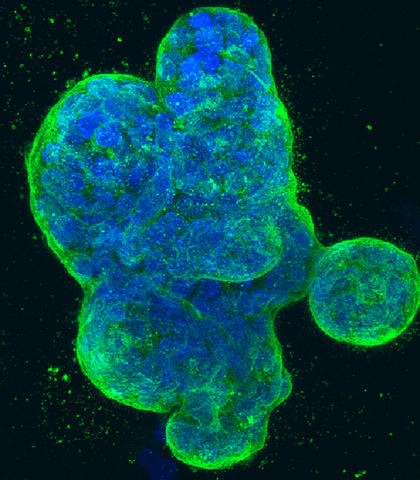NIST and Frederick National Laboratory for Cancer Research Help Ensure Accurate Clinical Measurements of HER2 Breast Cancer Gene

Three-dimensional culture of human breast cancer cells, with DNA stained blue and a protein in the cell surface membrane stained green. The cancer in these cells is driven by the HER2 gene (also known as ErbB2).
A new measurement standard developed by the National Institute of Standards of Technology (NIST) has been used successfully by the Frederick National Laboratory for Cancer Research to check the performance of next-generation DNA-sequencing technologies for evaluating gene variations associated with an increased risk of breast cancer.
Scientists at the Molecular Characterization Laboratory (MCL) at the Frederick National Lab, which is sponsored by the National Cancer Institute, evaluated the usefulness of the NIST HER2 Standard Reference Material (SRM 2373) for ensuring the accuracy of measurements of HER2 gene copy numbers. Excessive copies of the HER2 gene indicate heightened risk for an aggressive form of breast cancer.
The trial run “clearly demonstrated the value of SRM 2373” for both evaluating assay performance and “increasing confidence in reporting HER2 amplification for clinical applications,” Frederick National Lab and NIST researchers report in the new issue of the Journal of Molecular Diagnostics.
“The gene is a biomarker for treatment selection. Diagnostic sequencing tests like HER2 assays make it possible to select the best treatment for individual patients based on the genetic makeup of their tumors,” said MCL Director Mickey Williams.
Normal cells have two copies of HER2, but about 20 to 25 percent of breast cancers have multiple copies of the gene, resulting in overproduction of the HER2-encoded protein. This gene amplification stimulates tumors to be particularly fast growing in this subset of breast cancer patients—about 40,000 women in the United States annually.
Fortunately, these patients can be treated with a monoclonal antibody called trastuzumab (brand name Herceptin) that targets and inhibits the growth of tumor cells with higher-than-normal levels of the HER2 protein. The combination of more traditional chemotherapy drugs plus trastuzumab has been found to increase long-term survival rates significantly.
The treatment also can have adverse side effects, so it’s important to screen for those patients who would benefit from it by testing them. However, the two primary tests used prior to the ongoing transition to genomic screening—one relying on fluorescent probes and the other on tissue staining—have been prone to error. An estimated 20 percent of tests were estimated to yield inaccurate results, either false positives or false negatives.
In fact, NIST had originally set out to develop measurement tools to improve the accuracy of those diagnostic tests. But with the rapid emergence of next-generation genome sequencing, NIST chose, instead, to focus on developing measurement references that support the more sensitive and more specific detection capabilities of the new technologies.
SRM 2373 consists of DNA extracted from five breast-cancer cell lines, each with a different average number of copies of the HER2 genes, relative to a selected set of unvarying reference genes. Across the five-vial set, NIST-certified ratios of HER2 copies to the reference genes range from just over one to about 18.
“The collaboration with the Frederick National Lab is very valuable for NIST to ensure that the reference materials we develop are relevant and timely to meet the needs of the clinical and research communities in the rapidly changing field of molecular diagnosis of cancer,” said NIST biochemist Kenneth Cole.
The HER2 reference material is the latest addition to a growing list of measurement tools that NIST has developed to help advance genomics-inspired precision medicine. NIST also is working with Frederick National Lab researchers and industry to improve detection and reliable measurement of cell-free circulating tumor DNA, sometimes called liquid biopsies. Circulating tumor DNA has been detected in many cancers and might be used to monitor patients’ therapeutic progress and whether tumors mutate to become resistant to treatments.
NIST recently signed a three-year Cooperative Research and Development Agreement with SeraCare Life Sciences to collaborate on an interlaboratory study comparing measurements of the company’s circulating tumor DNA reference material.
In 2015, NIST and its partners in the Genome in a Bottle Consortium issued NIST Reference Material (RM) 8398 Human DNA for Whole-Genome Variant Assessment, for which about 77 percent of the genome is characterized with high levels of confidence. The Food and Drug Administration used the genome reference material as its “truth set” for its just-completed PrecisionFDA Consistency Challenge, intended to advance quality standards for whole human genome sequencing.
In May 2016, NIST issued a “Peptide Mixture for Proteomics” (RM 8321), which contains 440 synthetic peptides, or segments of proteins. Proteomics is the identification and study of proteins, which are encoded by genes and are, ultimately, the body’s “doers,” acting alone or in groups to drive processes involved in health and disease.
Articles:
H-J. He, J. Almeida, S. Lund, C.R. Steffen, S. Choquette and K.D. Cole. Development of NIST Standard Reference Material 2373: Genomic DNA Standards for HER2 Measurements. Biomolecular Detection and Quantification, Published June 2016. DOI: doi:10.1016/j.bdq.2016.02.001
C-J. Lih, H. Si, B. Das, R.D. Harrington, K.N. Harper, D.J. Sims, P.M. McGregor, C.E. Camalier, A.Y. Kayserian, P.M. Williams, H-J He, J. Almeida, S.L. Lund, S. Choquette and K.D. Cole. Certified DNA Reference Materials to Compare HER2 Gene Amplification Measurements Using Next-Generation Sequencing Methods. Journal of Molecular Diagnostics. Available online July 25, 2016. DOI: 10.1016/j.jmoldx.2016.05.008

